By Tom Frascella August 2010
There has been a legion of young men and women from the town of San Fele who through the centuries have chosen to devote their lives to religious life. While most have labored in the faith known only to those that they selflessly served a few have been recognized by the Church for their extraordinary and exemplary lives. The first San Fele resident so recognized was Francisco Antonio Frascella. Francisco was born in San Fele in 1600 and raised in a home located on the side of Monte Castello. The home which is still standing is identified by a plaque. Early in life Francisco recognized a vocation for religious life and entered into religious studies with the Order of St. Francis O.F.M.( Conv.) After being ordained Father Frascella was pleased to accept as an assignment work in the foreign missions of his Order. It should be noted that at this period in time the Church was beginning to look to internal reform in response to the rapid growth of the Protestant Reformation within Europe and concerns regarding abuse arising within the context of European colonial expansion. The Roman Catholic Church’s response to these concerns was the establishment of the Offices of the Propagation of the Faith in 1622. The formation of this appendage of the Church began the period known as the Counter Reformation.
Father Frascella left on his first foreign missionary assignment in 1627 at a time early on in the Counter Reformation effort. His assignment was to preach the gospel in that part of the world that today would be considered Eastern Europe and Western Russia. For any missionary in this era this part of the world was on the frontier of Western European influence. It also marked a boundary between Eastern Rite and Western Rite Catholic practice as well as increasing Lutheran Evangelism. Father Frascella remained in that assignment for seven years, preaching the gospel, baptizing and establishing churches. Father Frascella was dedicated to incorporating local language, customs and culture into the celebration of faith. He also advocated greater local participation and authority for local “native” clergy. His efforts resulted in many converts to Roman Catholicism in the region.
After seven years of highly successful missionary work his efforts were recognized by the Office of the Propagation of the Faith and he received a new assignment. In 1634 he was transferred and appointed chief administrator/coordinator of Jesuit and Franciscan missions in what today would be Eastern Hungary and Romania then known as Transylvania. Again, Father Frascella’s efforts of including and encouraging “native” clergy in positions of authority met with great success. At the time of Father Frascella’s ministry in this region, it like his previous assignment presented some unique challenges to his skills as a man of faith, an administrator and a diplomat. The area’s population was a culturally diverse mixture of long established Islamic, as well as Eastern and Western Rite Catholic Congregations under the foreign dominance of the Roman Catholic Austrian monarchy. To further complicate matters Jesuit and Franciscan missions did not always coordinate well which tested the diplomatic skills of Father Frascella.
After three years in the position of Administrator his successes were again recognized and in 1637 he was called to the principal offices of the Propagation of the Faith located in Paris, France. In France he was offered a new position and challenge, the position of Apostolic Vicar to Asia. This offer of appointment represented the first position of its type ever offered through the Offices of the Propagation of the Faith and had as its purpose to effectuate positive change in the Colonial Asian Roman Catholic Church. The position carried with it installation as an Archbishop of the Church conferred directly by the Pope Urban VIII. Father Frascella’s appointment was made at the same time as the appointment of an Apostolic Vicar to Goa India was made. Father Matthew De Castro, a Christian from a prominent Brahmin family in India who had been trained in Rome was chosen for the second Apostolic Vicar position. The two are recognized as the first two Apostolic Vicars appointed by a Pope directly through the Offices of the Propagation in Church History. As such the two were early pioneers in the Counter Reformation effort of the Church. In accepting their appointments both men knew that they would come in direct conflict with extremely powerful Portuguese colonial interests if they were to address the excesses and injustices of the developing colonial Church in Asia.
In 1637 both Father Frascella and De Castro travelled to Rome to be personally Consecrated Bishops by Pope Urban VIII. After installation the two new bishops were dispatched together on assignment to first try to resolve the worsening relationship between Portuguese supported Japanese Christian community and the Japanese shogunate authorities on the mainland of Japan.. Before leaving for Japan Archbishop Frascella made one final visit to San Fele in January 1638 the last time he was to see his hometown.
What was not fully appreciated at the time of their departure was that a series of shogunate imposed edicts had begun to be issued in Japan starting in 1633. Each of the edicts was directed at eliminating the political and religious influence of the Portuguese. The growing tension then led to a Japanese Christian peasant rebellion which was supported by the Portuguese This uprising known in Japan as the Shimbara Rebellion saw some 40,000 Japanese openly defy the shogunate and the local warlords. With the help of Dutch merchant fleet the shogun was able to brutally defeat and execute some 38,000 Japanese Catholic rebels in 1638. Following the defeat a purge of Christians and Western influence began throughout Japan. The elimination of all things foreign and particularly Christian is known as the sakoku policy which would remain in effect for over two hundred years. All foreign nationals were expelled from Japan in 1638 and any foreigner found on Japanese soil face immediate and summary execution.
Archbishop Frascella and Bishop De Castro travelled together but did not arrive at the coast of China, the gateway to Japan until 1639 well after the expulsion of all foreigners. Since all foreigners who might defy the ban were to be subject to summary execution upon setting foot on Japanese soil the two bishops had no way to directly access the surviving native Catholic population which might have escaped the slaughter. Thus Japan began a two hundred year period of isolation and the Catholic presence in Japan was eventually believed extinct. The sakoku policy would remain in force and in place until 1853 when it was shattered by the arrival of Commadore Matthew Perry and the American fleet in Tokyo Bay.
Little information is available to examine what directives or advice Archbishop Frascella could have smuggled into Japan to comfort a catholic Community under severe persecution. It is known that because of Japan’s strict anti-Western anti-Christian policies from 1638-1865 the Christian community of Japan was persecuted and forced underground. There were at least four major purges and attempts to completely wipe the community out during that period the last being in the mid 1800’s.The last Catholic priest to minister on the island of Japan following the 1637 rebellion, a ethnic Japanese, died in 1644. So complete was the isolation of the Japanese mainland and so intense was the Christian persecution that it was eventually assumed, even by Church leaders, that no Japanese Catholics had survived. However, a small underground Christian community without religious clergy was able to survive completely unknown to the West. This Japanese Christian community came to be known in Japanese as Kakure Kirishitan. The underground community remained invisible but viable throughout the period of isolation, developing their own distinct cultural and religious identity. Many from this community have in modern times rejoined the mainstream of Catholic religious community once access was available after 1865. However many of their distinct traditions developed during centuries of persecution and hiding have been retained. Many of those traditions were based on the need to practice their Christian religion while appearing to be practicing Buddhist or Shinto rites.
The adaptive blending of eastern practices into the Christian rituals in order to avoid detection by a hostile shogunate would I am sure been greatly appreciated by Archbishop Frascella. Of particular interest is the Japanese rendering of the image of Mary the Mother of Christ, an image common to many Christian households in Japan. The Japanese Christians in their time of persecution rendered the image in a particular style because in that form it resembled a well known traditional Buddhist icon. In fact this image of Mary with the infant Christ child is the most venerated within the community which regards Mary as their patroness.
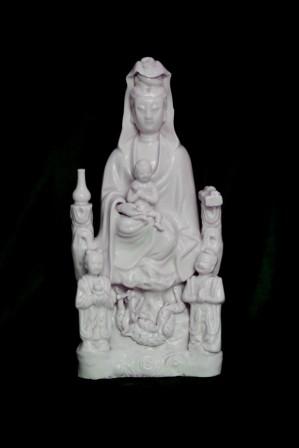
Japanese Ma Donna and Child as depicted in Japan 1637-1865
I find it an interesting coincidence that the image so closely resembles the Madonna Di Pierno icon. Whether Archbishop Frascella had any part in seeding this image among the faithful is unknown but Marian devotion would have been something that he would have fully appreciated.
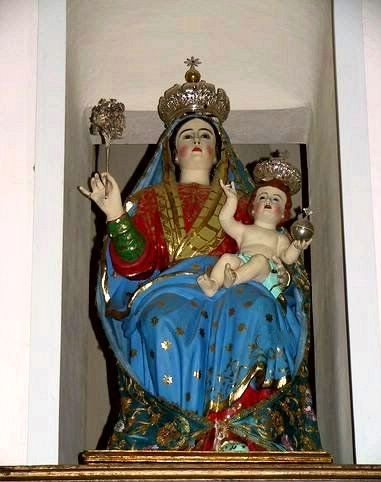
San Fele Ma Donna and Child
Unable to directly communicate with the Japanese mainland the Archbishop was forced to relocate the center of his ministry to what was then known as the Mogul Empire. The Mogul Empire at this time was ruled by an enlightened Emperor, a Muslim, who encouraged religious discourse within his Imperial Court. The Archbishop was able to obtain some open access to the Imperial territory during the period however, much of the Mogul Emperor’s extensive territories were governed as strict Islamic fiefdoms with little religious tolerance. Despite any regard for personal safety the Archbishop continued his missionary work travelling extensively in India, China and Southeast Asia. As a time reference his ministry covered a period during which the then Mogul Emperor built the most famous Indian structure the Taj Mahal.
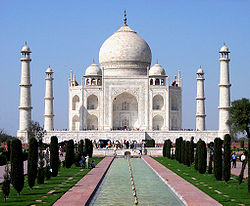
Taj Mahal
In all Archbishop Frascella spent around fifteen years in missionary service in Asia. On a number of occasions he found himself in situations where his faith put him in great personal danger and occasionally survived only with the help of local benefactors who at great personal risk would smuggle him by local authorities. Around 1651-1652 Archbishop Frascella was called back to the Headquarters of the Propagation of Faith in Paris. Unfortunately, shortly after his arrival in Paris he became ill and died in Paris in 1653-54. His remains were buried in a convent cemetery in Paris France although I believe some of his remains were returned to San Fele as spiritual relics.
After his death his life’s work and dedication to the Catholic missions was recognized with his beatification. With his beatification he became the first San Felese to be recognized as Blessed of the Church.. His life and work are commemorated with a plaque affixed to the main Church in San Fele, the Church of the Madonna of the Oak.. Also contained on the same plaque with Archbishop Frascella’s name are the names of fathers Giovanni Batiste-Guglielmo Leone O.F.M. Conv. (1630-1715) counsel to two Popes, Vincenzo De Jacobis (1794-1872) brother of St. Justin.
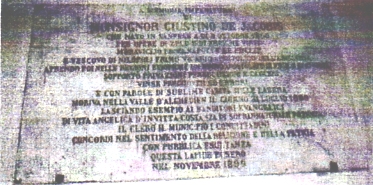
Plaque affixed to the Church of Maria of the Oaks in San Fele
St. Justin considered a martyr for the faith also has a plaque affixed to the Church.
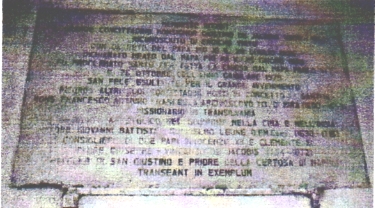
Plaque reciting the life of St. Justin Jacobis
affixed to the Church of Maria of the Oaks San Fele
After St. Justin’s canonization in the mid 1970’s a statue was erected in the town square by the Church as well. It is believed by the San Felese community that all four individuals recited in the plaques and honored in the town lead such exemplary lives that some day each may be officially recognized as a saint.
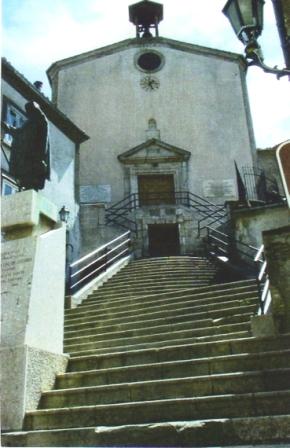
Stairs leading to Church of Maria of the Oaks in
San Fele, statue of St. Jacobis is on the left, plaques
are on either side of the main door of the Church
To bring the Japanese story full circle, the Vatican did not believe that the Catholic Church had survived in Japan after the purges. As a result it did not appoint another Apostolic Vicar to Japan after Archbishop Frascella until 1846 almost two hundred years after Archbishop’s ministry. After Commodore Perry’s arrival a treaty was reached allowing the US and
several European nations limited access to a few ports within segregated foreign enclaves on Japanese soil. Around 1860 foreign Churches of worship were allowed to be built on Japanese soil but only within those enclaves. Christian ministers were however not allowed to export religion among the Japanese. When the first Catholic Church was built within one of these enclaves in the mid 1860’s it became an instant object of curiosity bringing many Japanese visitors. The story goes that the French priests who were assigned to the Church were surprised when they were approached one day by a number of Japanese who confided secretly that they too were Christian in faith. It is recorded from that meeting that the first request the Japanese Christians made was to see the Churches statue of Mary. Those same Kakure Kirishan’s then arranged to smuggle the priests to small Christian meetings outside of the enclaves allowing for mass to be said once again within the community. To this day Marian devotion is very strong in the Japanese Christian community.